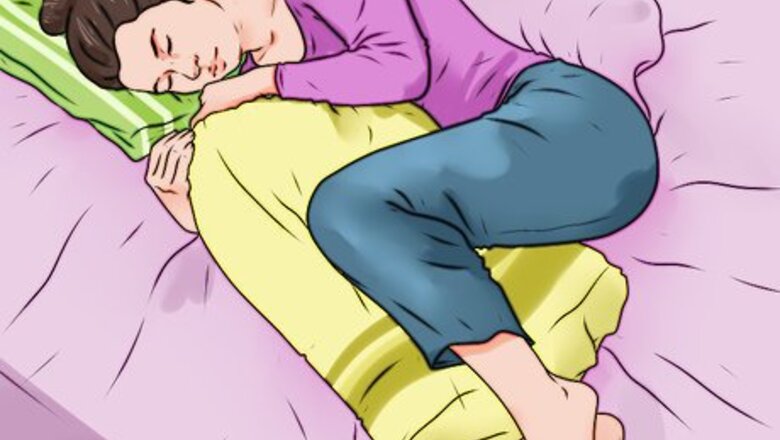
views
Adjusting Your Lifestyle
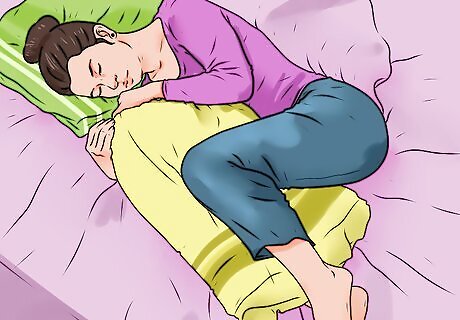
Change your sleeping position. Lie on your side with your back straight. Lift your knees forward into a fetal position. Place a long pillow between your knees and your ankles to support your hips. Hug a pillow near your chest to relax your neck and arms.
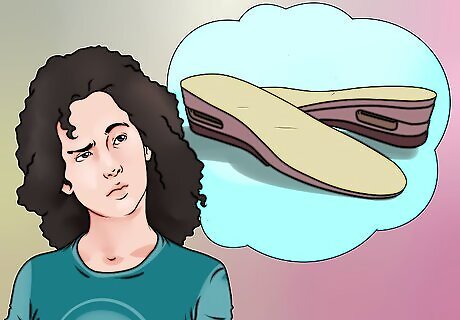
Invest in better footwear or insoles. If you are on your feet, make sure comfort is your first priority. You want to make sure that you're shoes have excellent arch support. This will help you maintain balance without putting too much strain on the base of your foot. See a podiatrist if you suffer from pronation or supination.
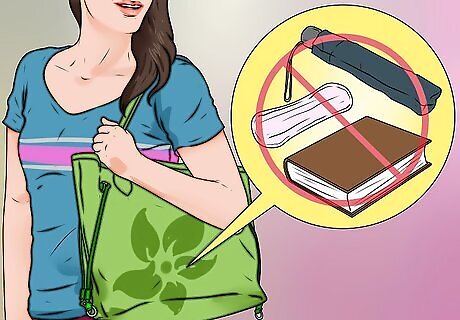
Ditch the heavy bags. Pack pragmatically. Don't carry around things that you might need. Pack what you will need, so you can keep it light. And then purposefully switch your bag to different arms over the course of your day. Put it on your left shoulder, right shoulder, carry it on your arm or in your hand, and put it on your lap or the floor whenever you are seated. This way the strain of the bag will be displaced evenly across your body.
Strengthening Your Back
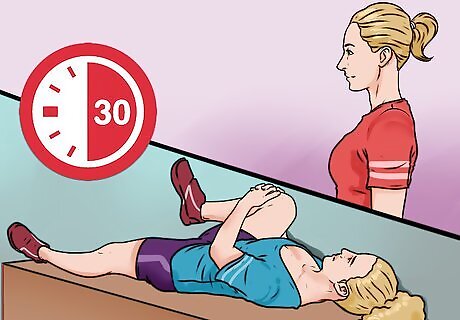
Stretch several times per day. The following stretches can greatly reduce pain if done at least once per day: Do the knee-to-chest stretch. Lay on your back with your knees up and your head on the ground. Lift your right knee and grab it with both hands. Pull the knee lightly toward your chest for 30 seconds. Release and repeat 2 times with both legs. Do the piriformis muscle stretch. If you suffer from pain in your sciatic nerve, the piriformis muscle is most likely extremely tense. Lie on your back with your knees up. Place the outside of your right calf on the top of your left thigh. Lift your left thigh and grab it with your hands. Bring the thigh toward you until you feel a stretch in your right buttock. Hold for 30 seconds and release. Repeat twice on each side. Focus on your neck. Stiff necks often accompany stiff backs. Lean your head forward so that your chin touches your chest. You should feel the muscles in the back of your neck stretch. Hold for 30 seconds. Lift your head up and then lean your head to the right, bringing your right ear close to your right shoulder. The muscles on the side of your neck should be pulled taught. Hold for 30 seconds and then lean your head to the left, in the same way. Hold for 30 seconds. EXPERT TIP Eric Christensen, DPT Eric Christensen, DPT Physical Therapist Eric Christensen is a Physical Therapist based in Chandler, Arizona. With over a decade of experience, Eric works in both orthopedic and neurological fields and specializes in custom orthotic prescription and casting, vestibular reprogramming, and manual therapy. He holds a Bachelor’s degree in Exercise Science with a focus in Sports Medicine from Colorado State University and a Doctor of Physical Therapy from Regis University. In practice, Eric takes a developmental approach to rehabilitation utilizing the Selective Functional Movement Assessment. He uses functional movement patterning and manual therapy to return patients to prior levels of function. Eric Christensen, DPT Eric Christensen, DPT Physical Therapist Try a gentle windshield wiper stretch. The windshield wiper move stretches out stiff lower backs. Just lie flat with knees bent and feet together, then let both knees slowly sweep from side to side, like a wiper going across a windshield. It's easy!
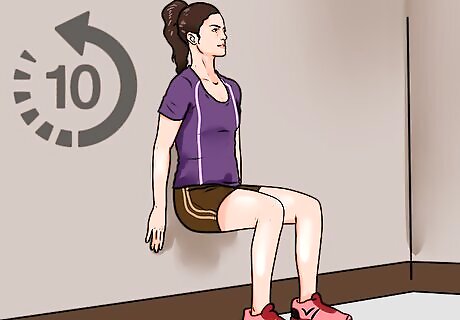
Strengthen your core with wall squats. Stand with your back against a wall. Then gradually lower yourself so that you are in a seated position. You should feel your back, abdomen, and quads start to tighten. Hold for 5-10 seconds depending on how long it takes you to feel the burn. Then slowly straighten your legs and return to a standing position. Do this 10 times or so each time you work out.
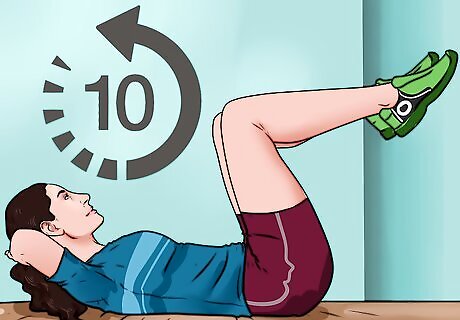
Do pelvic lifts to build your core. Lie on your back and bend your knees, so that your feet rest comfortably on the floor. Then slowly lift your pelvis off of the floor until your thighs line up with your core. Do not go too far. You don't want to over arch your back. Hold for 5 seconds and then lower your pelvis back to the floor. Repeat 10 times or so each time you work out.
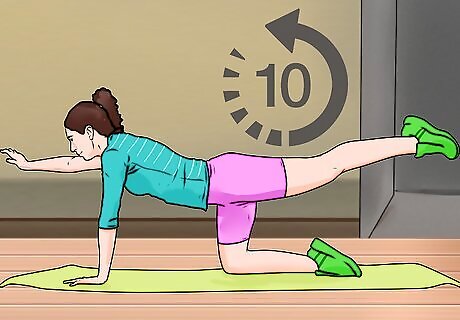
Do leg reaches. Find an open space for this exercise. Begin on your hands and knees like you are a crawling toddler. Hold your head straight so that you're looking down at the floor. Holding your body firm, slowly extend one leg out behind you. Fully extend your leg so that it is on level with your back and then hold for 5 seconds. Now lower your leg back to the ground. Repeat 10 times with each leg.
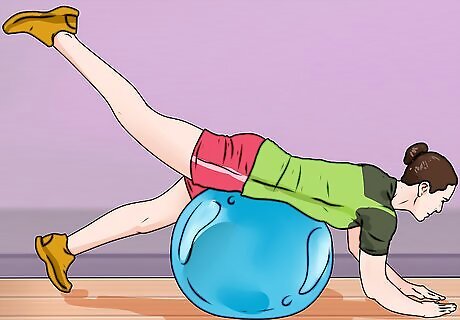
Perform Swiss ball stabilizing exercises. For this exercise, you'll need a large rubber Swiss ball. Roll onto the ball. Your stomach should rest comfortably on it. Now extend your upper body and legs out. Then slowly walk your body forward so the ball is now under your thighs. Keep your body as straight as possible. Then walk your body back so the ball is under your stomach again. Do this 10 times per trip to the gym.
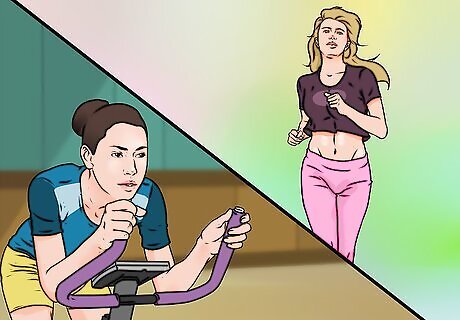
Add more cardio exercise to your daily workout. 30 minutes per day of low-impact aerobic exercise, such as swimming, fast walking, or cycling on a recumbent bike, will reduce back pain caused by atrophy over time. The increased blood pressure will help wake up those dormant muscles. After 30 to 40 minutes of cardio exercise, your body will kick into endorphin production, which can alleviate back pain.
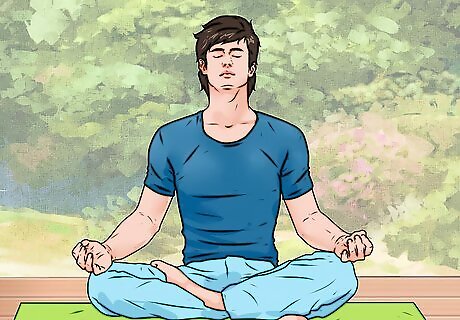
Do yoga. Yoga will further reinforce the above stretches and exercises as well as reduce stress which can lead to back pain. Focus on your breathing, while you complete each pose. The cobra, child's pose, and mountain pose are excellent yoga positions for strengthening your core and stretching your back muscles. There are dozens of other poses that focus on your core and back specifically. Try those that feel most comfortable to you. You don't want to push yourself too far. Over extension can lead to additional back problems, if you aren't careful.
Back Pain Relievers
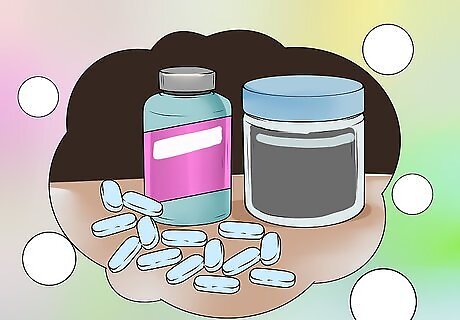
Take anti-inflammatories (NSAIDs). Follow the manufacturer's recommendations. NSAIDs, or non-steroidal anti-inflammatory drugs, help decrease inflammation and relieve pain. Over-the-counter drugs such as Motrin, Aleve, or Bayer Aspirin can provide quick relief and are readily available at your local pharmacy. Common side effects include gas, heartburn, nausea, dizziness, or diarrhea. If symptoms persist, stop the medication and consult a doctor. Many doctors say that people under 18 shouldn't take aspirin because of its association with Reye's Syndrome - a rare, but serious liver and brain disorder.
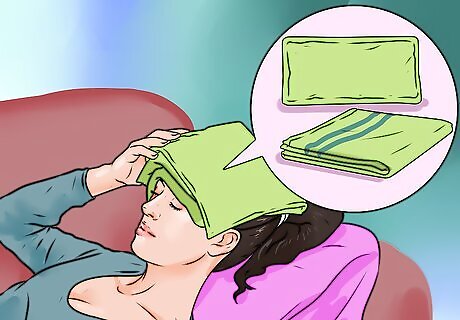
Use hot and cold compresses. Start with a warm compress for 15 minutes, followed by a cold compress. Alternate every 2 hours for 5 days. Hot and cold packs can reduce inflammation for people with acute, subacute, or chronic pain. For cold compresses, wrap a gel-based ice pad or ice pack in a shirt or towel before placing it directly on the skin. Otherwise, it can be shockingly cold.
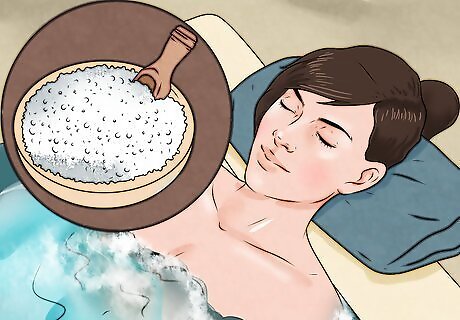
Take regular baths with epsom salts. This is particularly useful if you have back pain from manual labor or standing too much. Epsom salts contain minerals that relax inflamed muscles. Doctors call this “hydrotherapy”. Don't make the water too hot. You don't want to scald yourself. These baths get your nervous system revved up and help circulate blood to strained or injured areas. Give yourself a hot bath massage. Since your muscles will be loosened by the water, now is a good time to work out any tight areas. Take a baseball or tennis ball and put it under your lower back and move your hips from side to side. Then do the same for your upper back.
Seeking Professional Help
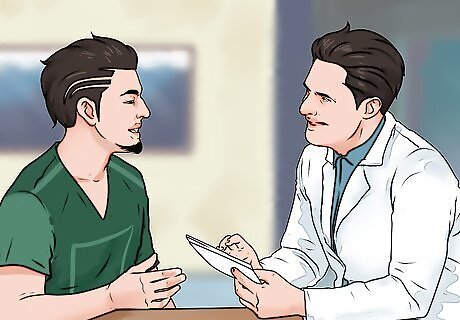
Talk to a physician. Seek professional help from your doctor immediately if you feel any numbness or tingling in your groin or legs, if you lose control of your bladder or bowels, or if your walk is affected. You should also see your doctor if you are unsure of the cause of your back pain or if it is getting worse. You will need further evaluation if you develop a fever or any new symptoms. Be able to describe the exact nature of your back pain, how frequently your back hurts, what activities have become unbearable due to back pain, and any additional information that your physician might find useful.
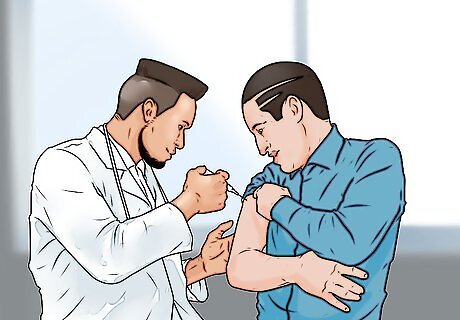
Consider a steroid injection. Depending on the severity of the back pain, a doctor may suggest a steroid injection. Some people get relief for months or years when a steroid is injected into areas of the spine that suffer from extreme inflammation.
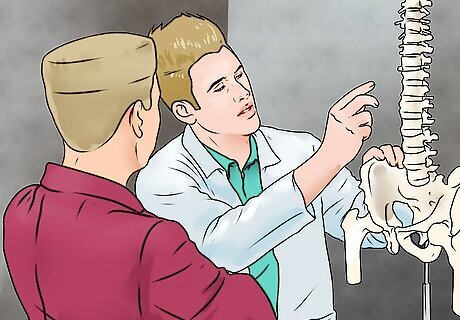
See a chiropractor. Chiropractic professionals are dedicated to the non-surgical treatment of musculoskeletal conditions. Generally, they focus on your spine and the surrounding areas. Chiropractors use manual (hands-on) treatment to focus on lower back pain and herniated disc issues.
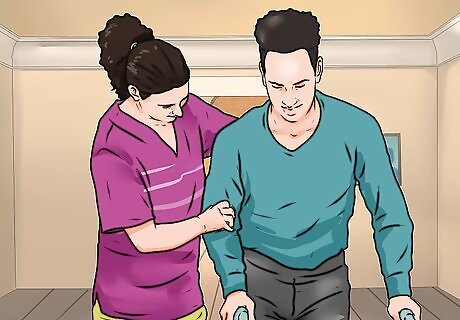
Go to a physical therapist. This trained professional will prescribe necessary exercises much like a doctor prescribes medication. Physical therapists will teach you how to stretch and strengthen your back muscles. They'll also help you prevent unnecessary strain. Egoscue practitioners specialize in posture therapy. He'll focus on your back pain and identify any posture problems you may be having. He'll examine the way you walk, sit, and sleep. Afterwards, he'll outline a series of exercises that will help reduce pressure and tension in your back.
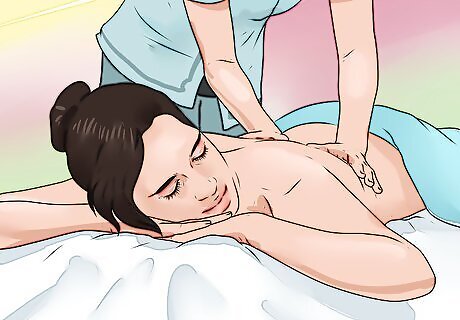
Get a massage. The two best massages for lower back pain specifically are a quadratus lumborum (QL) muscle massage and a gluteus medius massage. The QL massage focuses on the connection between your ribs and your pelvis - an area that is normally a source of lower back pain. This area becomes strained when your lower back remains mobile while your upper body sits still or when you sit slumped in a chair. Your therapist can stretch and massage this area with a QL massage. The gluteus medius massage works wonders in tandem with the QL massage. When the area between your ribs and pelvis becomes strained, it immediately causes strain in your upper buttocks region as well.
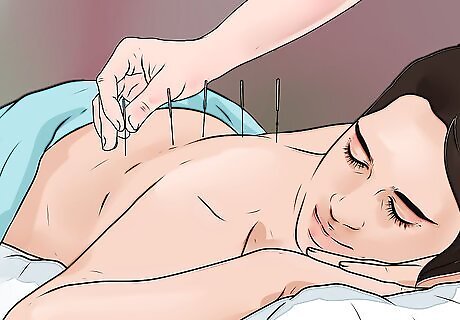
See an acupuncturist. A practitioner will insert thin needles into precise points throughout your body. Most acupuncturists argue that their needles stimulate the production of endorphins, serotonin, and acetylcholine. These are powerful painkilling chemicals naturally produced in your body. While the medical community is still out on the exact scientific effects of acupuncture, on-going clinical trials are hopeful. Certainly, there is a lot of anecdotal evidence (by patients) to support acupuncture's effectiveness.
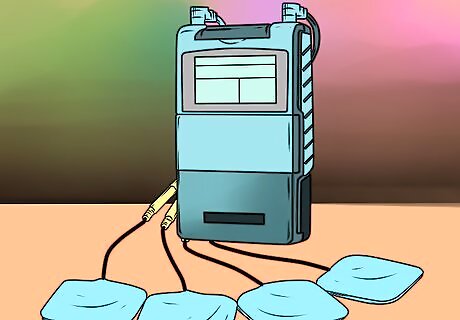
Use a nerve stimulator. A Transcutaneous Electrical Nerve Stimulator (TENS) unit may be used as a treatment option to help block severe nerve pain. This is not a cure. It is merely a pain management technique. It essentially blocks pain signals to the brain, so you don't notice your back pain as much or at all. Only consider this technique after consulting your doctor and if all other methods have failed.













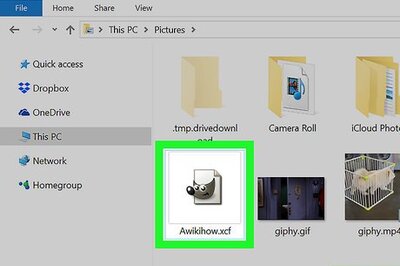




Comments
0 comment